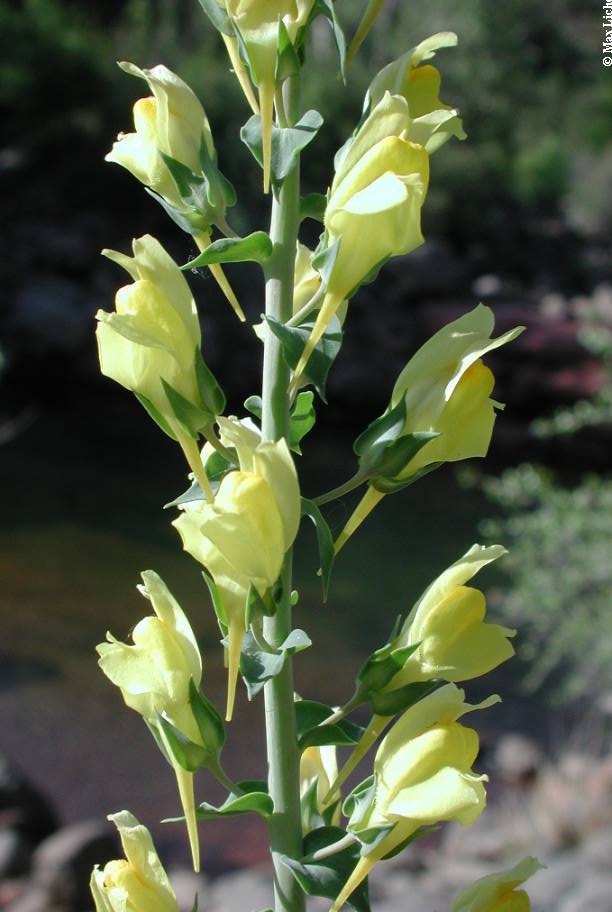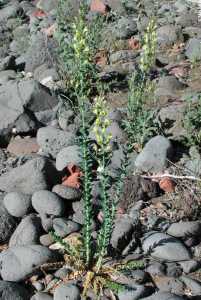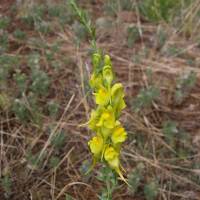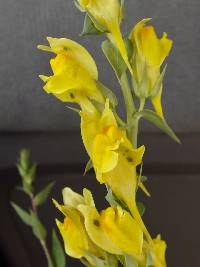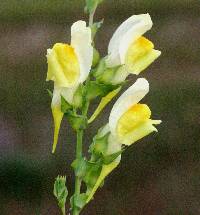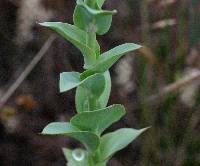|
|
|
|
Family: Plantaginaceae
Dalmatian toadflax, more...Dalmatian toadflax
[Linaria dalmatica subsp. macedonica (Griseb.) D.A. Sutton, moreLinaria dalmatica var. macedonica (Griseb.) Vandas, Linaria genistifolia subsp. dalmatica (L.) Maire & Petitmengin, Linaria macedonica Griseb.] |
Stout, glaucous perennial, branched above, 4-12 dm, colonial by creeping roots; lvs numerous, ovate or lance-ovate, sessile and clasping, palmately veined, 2-5 נ1-2+ cm; fls short-pedicellate or subsessile in elongate racemes, bright yellow, with well developed, orange-bearded palate, 2.5-4 cm, the spur about as long as the rest of the cor; fr broadly ovoid-cylindric, 6-8 mm; seeds irregularly wing-angled; 2n=12. Roadsides and other disturbed sites; e. Mediterranean sp., now well established in arid w. U.S., and occasional with us. July, Aug. Gleason, Henry A. & Cronquist, Arthur J. 1991. Manual of vascular plants of northeastern United States and adjacent Canada. lxxv + 910 pp. ©The New York Botanical Garden. All rights reserved. Used by permission. Jepson 2012 Duration: Perennial Nativity: Non-Native Lifeform: Forb/Herb General: Herbaceous perennials, to 1 m tall, stems erect, simple or branching at the base, herbage glabrous, leaves crowded on the stems. Leaves: Opposite, alternate (distally) or whorled, sessile and clasping, rigid, lanceolate to ovate with acute to long-tapered tips, generally wider on non-flower shoots, margins entire to dentate, surfaces pinnately veined. Flowers: Yellow, densely white- to orange-hairy, flowers 5-lobed and 2-lipped, the lower lip rounded on top and larger than the upper lip, corollas 20-50 mm long, lower lip closing the throat and side of tube spurred at base, lower side of throat swollen and hairy, sepals 5, free to near base, with roughly equal lobes, calyx 2-12 mm long with linear to triangular-ovate lobes, stigma lobes absent, stamens 4, in 2 pairs, included, flowers borne in dense to open spikes or racemes, the terminal bracts reduced and alternate, pedicels 1-13 mm long. Fruits: Spheric capsules opening by slits into chambers near tip, 3-7 mm long. Seeds many, pyramid-shaped, roughly 1 mm long with ridged surfaces. Ecology: Naturalized, found on roadsides, in fields, open areas in yellow-pine forest, pinyon/juniper woodland, and sagebrush scrub communities, to 6,500 ft (1981 m); flowering April-September. Distribution: Widespread across much of the United States, including Arizona, New Mexico, California, and Nevada. Not present in Texas. For more information, see the USDA Plants website or FNA. Notes: This pretty toadflax has bright yellow flowers on long, slender infloresences. Ethnobotany: Specific uses for this species are unknown, but other species in the genus have uses. Synonyms: None Editor: LCrumbacher2012 Etymology: Linaria comes from the Latin linum, "flax," referring to the flax-like leaves of some species, and dalmatica means of or from Dalmatia on the Adriatic side of the Balkan Peninsula. |


